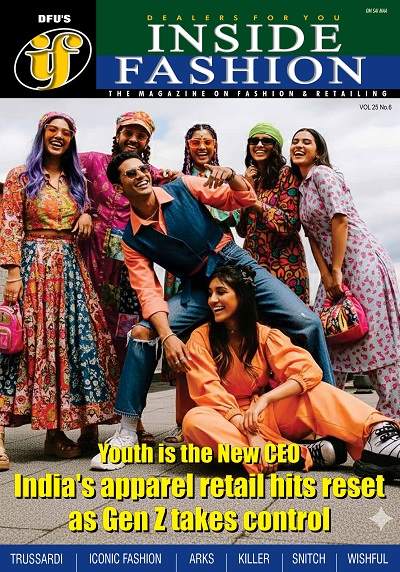The Kidswear Turnaround: When conscious parenting becomes a market-moving force

28 November 2025, Mumbai
For years, India’s kidswear category existed in the shadows of mainstream fashion, dictated by necessity, dominated by unorganized markets, and shaped by value-first buying behaviour. Today, that paradigm has flipped. The segment is being recast by a new force: the informed, digitally native, financially empowered Indian parent.
With global kidswear valued at over $145 billion, the momentum is unmistakable. But in India, the shift feels more cultural than commercial.
Parenting itself has changed from ‘what’s available’ to ‘what’s safest, most sustainable, and best designed’. The result is a sector on the cusp of unprecedented scale and structural evolution.
Read our latest issue
Market growing faster than the industry that hosts it
Recent data highlights how kidswear is outpacing broader apparel growth.
Table: Market momentum
|
Market details |
Data |
Source/Context |
|
Market Value (2024) |
$22.1 Billion – $24.56 Billion (Approx.) |
Reflects a rapid shift from traditional to organized retail. |
|
Projected Market Value (by 2033/2034) |
Up to $27.1 Billion – $29.35 Billion |
Driven by rising urbanization and middle-class expansion. |
|
Compound Annual Growth Rate (CAGR) |
3.01% – 5.8% (Forecast period) |
Indicates robust, sustained growth faster than the general apparel segment. |
|
Per Capita Disposable Income |
Reached approx. ₹2.14 lakh (2023-24) |
Empowering urban households to increase spending on quality/premium kidswear. |
|
Unorganized Market Share |
Over 95% |
Presents a massive long-term opportunity for branded, D2C, and organized players to consolidate. |
The table highlights the immense headroom for growth. Even with a billion-dollar market today, 95 per cent remains unorganized, signalling potential for consolidation similar to adult apparel in the early 2000s.
Rising disposable income is not just enabling better choices it is creating a generational shift in expectations. What’s different this time is the mindset of Indian parents.
They are willing sometimes eager to spend more on children's apparel than they would on their own, because the purchase is tied to emotion, safety, and identity.
The conscious parent
The most profound transformation in kidswear isn’t happening on the shop floor, it’s happening in the living room. Today’s parents are informed consumers who treat kidswear purchases almost like health decisions.
Today’s parents are highly educated and globally exposed. They scrutinize labels, prioritizing organic cotton, bamboo fibre, and handwoven fabrics over synthetics. The focus is on comfort, durability, and health, demanding garments made with toxin-free (AZO-free) dyes and minimal chemical intervention to safeguard children’s sensitive skin.
The choice of the best for the child often translates into making better choices for the planet. This awareness is quantifiable: surveys indicate that 80 to 89 per cent of Indian parents are willing to pay a premium for certified organic and eco-friendly products for their children. Sustainability has moved from a niche concept to a core buying motivator.
The rise of ‘Mummy & Me’ or twinning outfits has turned children's clothing into an Instagrammable trend. This trend is driving new design ideas and cross-selling opportunities for brands that successfully weave family storytelling into their marketing.
How brands are playing
Amid this cultural shift, a new breed of brands has emerged digital-first, sustainability-led, and sharply attuned to the psychology of the modern Indian parent. Direct-to-consumer players have found fertile ground in kidswear for a simple reason: children grow fast. This creates a natural repeat purchase cycle that leans heavily toward online convenience. Compared to adult clothing, sizing issues are fewer and brand loyalty forms faster. Brands like Hopscotch understood this early, positioning themselves not just as product sellers but as partners in parenting. Their campaigns short, sharp, and relatable speak to aspiration and assurance.
Table: The power of conscious D2C
|
Brand |
Strategy |
Impact |
|
Kidbea |
Focus on innovation: uses bamboo fibre to create chemical-free, spill-proof, anti-bacterial, and ultra-soft products. |
Doubled net revenue to Rs 42 cr in FY25, demonstrating that parents will invest in product innovation backed by sustainability claims. |
|
Ed-a-Mamma |
Founded by actor Alia Bhatt, the brand uses GOTS-certified organic cotton, plastic-free buttons, and nickel-free trims, championing eco-conscious fashion. |
Acquired by Reliance Retail for approximately Rs 300 cr in 2023, validating the potential of the sustainable kidswear D2C segment for mainstream retail giants. |
|
Greendigo |
Offers 100 per cent GOTS-certified organic clothing, providing transparency to alleviate parental concerns about product authenticity. |
Focuses on functionality (heat-transfer labels, flat seams) and long-lasting durability, directly addressing the pain points of informed parents. |
Ed-a-Mamma, founded by actor Alia Bhatt, crafted a narrative that blends celebrity influence with ethical manufacturing GOTS-certified cotton, plastic-free buttons, recyclable packaging. When Reliance Retail acquired it for around Rs 300 crore, it was a clear signal that sustainability-driven kidswear has entered the mainstream.
Greendigo has taken a different path, focusing strongly on authenticity and transparency. By highlighting the purity of its materials and eliminating common discomfort-causing elements like scratchy labels or rough seams, it builds trust in a market where parents often question the authenticity of sustainability claims.
Traditional retail players are not staying silent. International brands like H&M Kids and Zara Kids are aggressively expanding their footprints, while domestic labels such as Mini Klub and Gini & Jony are tapping into the aspirational energy of smaller cities.
What is particularly interesting is that Tier II and Tier III markets once perceived as value-driven are emerging as strong adopters of branded kidswear. Rising incomes, better mall penetration, and exposure to global trends through influencers have altered buying habits in these regions faster than anticipated.
New opportunities and challenges
Even with all the momentum, the Indian kidswear sector faces very real challenges that shape its future growth path. The biggest among them is the paradox of price. Sustainable fabrics and ethical production processes are expensive. The cost of organic cotton, bamboo fibre, or hemp is significantly higher than synthetic alternatives. Certifications like GOTS add another layer of cost.
For affluent urban parents, the premium is acceptable. But for large parts of the country, especially outside metros, price remains a key determinant. The tension between aspiration and affordability continues to define brand strategies.
Logistics is another hurdle. India’s high logistics cost nearly 14 per cent of GDP affects delivery timelines, return management, and profitability. For D2C brands operating on tight margins and catering to scattered pin codes, this can be a structural constraint. Reliable availability of organic raw materials and ethical manufacturing partners adds to the complexity, particularly for emerging startups.
The regulatory environment has also become more demanding. The GST increase to 12 per cent for all apparel, including kidswear, eliminated the earlier lower tier that benefitted items under Rs 1,000. This change has pushed up prices for families and increased compliance burdens for manufacturers. In a segment as sensitive to price perception as kidswear, such shifts can influence consumer behaviour significantly.
Yet, in the midst of these barriers lie opportunities that are uniquely Indian. Circular fashion long a cultural norm through hand-me-downs is being formalized into resale and rental models.
Festive and ethnic kidswear is seeing a resurgence, as families look for modern, comfortable traditional wear for celebrations that occur almost monthly across India’s diverse cultural landscape. Tier II and III cities offer a long runway for growth, with stores increasingly catering to their evolving tastes.
Ultimately, the revolution underway in India’s kidswear market is about something deeper than product design or retail expansion. It reflects the evolution of Indian parenting.
Today’s parents are more involved, more aware, and more demanding of quality and accountability.
Their choices are shaped by global aspirations but rooted in cultural values. Kidswear, therefore, is no longer just a commercial category it has become an expression of care, identity, and hope.
As India moves through the next decade, the brands that will lead this space are the ones that understand the emotional weight of children’s clothing. They must combine innovation with trust, sustainability with affordability, and storytelling with authenticity. The future of fashion in India may very well be defined not by adults chasing trends but by children whose wardrobes reflect a nation’s evolving dreams.











